Use of a MODIS Satellite-Based Aridity Index to Monitor Drought Conditions in the Pearl River Basin from 2001 to 2021
Abstract
:1. Introduction
2. Materials and Methods
2.1. Study Area
2.2. Data
2.2.1. MODIS Satellite Data
2.2.2. Precipitation Data
2.2.3. Other Datasets
2.3. Methods
2.3.1. The Satellite-Based Aridity Index (SbAI)
2.3.2. Trend Analysis
3. Results
3.1. Temporal Trends of the SbAI
3.1.1. Annual Trends of the SbAI
3.1.2. Monthly Trends of the SbAI
3.1.3. Drought Events Detected by SbAI
3.2. Spatial Patterns of the SbAI
3.3. The M–K Test for the Spatiotemporal Trends of the SbAI
3.4. Temporal Trends of the SbAI in the Representative Regions of Areas 1 and 6
3.4.1. Temporal Trends of the SbAI in Areas 1 and 6
3.4.2. Monthly Fluctuations of the SbAI in Areas 1 and 6
4. Discussion
4.1. Accuracy Assessemnt
4.2. Comparisons with Previous Studies
4.3. Implications for Sustainable River Basin Management
5. Conclusions
- (1)
- The inter-annual SbAI in the Pearl River Basin exhibited a significant downward trend. The decreasing trend in the SbAI was statistically significant in the dry season, and the monsoon season also showed a decreasing except for an insignificant increase in June.
- (2)
- In the dry season, areas with droughts are mainly located in sub-regions of Areas 1, 2, and 3; as the flood season arrives, the basin receives more water and gradually becomes humid, and the total area with droughts decreases rapidly.
- (3)
- In the past 20 years, most parts of the Pearl River Basin have become wetter. However, the drought conditions illustrated an insignificant increase in the monsoon season, corresponding to a more statistically significant shrinking in the dry season.
- (4)
- Overall, the Pearl River Basin has become wetter over the past two decades, which may be the result of natural and human factors (i.e., increased precipitation and vegetation coverage); areas with increased drought conditions were likely impacted by human activities such as water withdrawal for irrigation and industrial uses, fast urbanization and increased impervious surfaces and the resulting reduction in water storage capacity.
Author Contributions
Funding
Data Availability Statement
Acknowledgments
Conflicts of Interest
References
- West, H.; Quinn, N.; Horswell, M. Remote sensing for drought monitoring & impact assessment: Progress, past challenges and future opportunities. Remote Sens. Environ. 2019, 232, 111291. [Google Scholar]
- Tabari, H. Climate change impact on flood and extreme precipitation increases with water availability. Sci. Rep. 2020, 10, 13768. [Google Scholar] [CrossRef] [PubMed]
- Cook, B.I.; Mankin, J.S.; Anchukaitis, K.J. Climate change and drought: From past to future. Curr. Clim. Chang. Rep. 2018, 4, 164–179. [Google Scholar] [CrossRef]
- Wilhite, D.A. Drought as a natural hazard: Concepts and definitions. In Drought: A Global Assessment; University of Nebraska-Lincoln: Lincoln, NE, USA, 2000. [Google Scholar]
- Palmer, W.C. Meteorological Drought; US Department of Commerce, Weather Bureau: Washington, DC, USA, 1965; Volume 30. [Google Scholar]
- McKee, T.B.; Doesken, N.J.; Kleist, J. The relationship of drought frequency and duration to time scales. In Proceedings of the 8th Conference on Applied Climatology, Anaheim, CA, USA, 17–22 January 1993; pp. 179–183. [Google Scholar]
- Vicente-Serrano, S.M.; Beguería, S.; López-Moreno, J.I. A multiscalar drought index sensitive to global warming: The standardized precipitation evapotranspiration index. J. Clim. 2010, 23, 1696–1718. [Google Scholar] [CrossRef] [Green Version]
- Kogan, F.N. Application of vegetation index and brightness temperature for drought detection. Adv. Space Res. 1995, 15, 91–100. [Google Scholar] [CrossRef]
- Rhee, J.; Im, J.; Carbone, G.J. Monitoring agricultural drought for arid and humid regions using multi-sensor remote sensing data. Remote Sens. Environ. 2010, 114, 2875–2887. [Google Scholar] [CrossRef]
- Zhang, A.; Jia, G. Monitoring meteorological drought in semiarid regions using multi-sensor microwave remote sensing data. Remote Sens. Environ. 2013, 134, 12–23. [Google Scholar] [CrossRef]
- Fayne, A. Current Environment of the Offshore Voluntary Disclosure Initiative (OVDI) Opt-out and Civil Exam Cases. J. Tax Pract. Proced. 2013, 15, 21. [Google Scholar]
- Dehghan, S.; Salehnia, N.; Sayari, N.; Bakhtiari, B. Prediction of meteorological drought in arid and semi-arid regions using PDSI and SDSM: A case study in Fars Province, Iran. J. Arid Land 2020, 12, 318–330. [Google Scholar] [CrossRef]
- Trenberth, K.E.; Dai, A.; Van Der Schrier, G.; Jones, P.D.; Barichivich, J.; Briffa, K.R.; Sheffield, J. Global warming and changes in drought. Nat. Clim. Chang. 2014, 4, 17–22. [Google Scholar] [CrossRef]
- Gidey, E.; Dikinya, O.; Sebego, R.; Segosebe, E.; Zenebe, A. Modeling the spatio-temporal meteorological drought characteristics using the standardized precipitation index (SPI) in raya and its environs, northern Ethiopia. Earth Syst. Environ. 2018, 2, 281–292. [Google Scholar] [CrossRef]
- Spinoni, J.; Naumann, G.; Carrao, H.; Barbosa, P.; Vogt, J. World drought frequency, duration, and severity for 1951–2010. Int. J. Climatol. 2014, 34, 2792–2804. [Google Scholar] [CrossRef]
- Hernandez, E.A.; Uddameri, V. Standardized precipitation evaporation index (SPEI)-based drought assessment in semi-arid south Texas. Environ. Earth Sci. 2014, 71, 2491–2501. [Google Scholar] [CrossRef]
- Chiang, F.; Mazdiyasni, O.; AghaKouchak, A. Evidence of anthropogenic impacts on global drought frequency, duration, and intensity. Nat. Commun. 2021, 12, 2754. [Google Scholar] [CrossRef]
- Dutta, D.; Kundu, A.; Patel, N.; Saha, S.; Siddiqui, A. Assessment of agricultural drought in Rajasthan (India) using remote sensing derived Vegetation Condition Index (VCI) and Standardized Precipitation Index (SPI). Egypt. J. Remote Sens. Space Sci. 2015, 18, 53–63. [Google Scholar] [CrossRef] [Green Version]
- Huang, W.; Yang, X.; Li, M.; Zhang, X.; Wang, M.; Dai, S.; Ma, J. Evolution characteristics of seasonal drought in the south of China during the past 58 years based on standardized precipitation index. Trans. Chin. Soc. Agric. Eng. 2010, 26, 50–59. [Google Scholar]
- Hänsel, S.; Ustrnul, Z.; Łupikasza, E.; Skalak, P. Assessing seasonal drought variations and trends over Central Europe. Adv. Water Resour. 2019, 127, 53–75. [Google Scholar] [CrossRef]
- Dong, Z.; Liu, H.; Baiyinbaoligao; Hu, H.; Khan, M.Y.A.; Wen, J.; Chen, L.; Tian, F. Future projection of seasonal drought characteristics using CMIP6 in the Lancang-Mekong River Basin. J. Hydrol. 2022, 610, 127815. [Google Scholar] [CrossRef]
- Jiménez-Muñoz, J.C.; Mattar, C.; Barichivich, J.; Santamaría-Artigas, A.; Takahashi, K.; Malhi, Y.; Sobrino, J.A.; van der Schrier, G. Record-breaking warming and extreme drought in the Amazon rainforest during the course of El Niño 2015–2016. Sci. Rep. 2016, 6, 33130. [Google Scholar] [CrossRef] [Green Version]
- Pramudya, Y.; Onishi, T.; Senge, M.; Hiramatsu, K.; Nur, P.M. Evaluation of recent drought conditions by standardized precipitation index and potential evapotranspiration over Indonesia. Paddy Water Environ. 2019, 17, 331–338. [Google Scholar] [CrossRef]
- He, Z.; Xu, S.; Xie, X.; Chen, H. Brief introduction of flood and drought disaster prevention in the Pearl River Basin in 2019. China Flood Drought Manag. 2020, 30, 24–26. [Google Scholar] [CrossRef]
- Wu, S.; Huang, F. Summary of flood and drought disaster prevention in the Pearl River Basin in 2021. China Flood Drought Manag. 2021, 31, 25–26, 43. [Google Scholar] [CrossRef]
- Qiu, J.; Cao, B.; Park, E.; Yang, X.; Zhang, W.; Tarolli, P. Flood monitoring in rural areas of the Pearl River Basin (China) using Sentinel-1 SAR. Remote Sens. 2021, 13, 1384. [Google Scholar] [CrossRef]
- Jing, J.-l.; Xu, Y.; Wang, Y.-f.; Dou, S.-q.; Yin, M. Characteristics of multi-scale drought and flood in the Pearl River Basin from 1960 to 2019. Res. Agric. Mod. 2021, 42, 557–569. [Google Scholar] [CrossRef]
- Deng, S.; Chen, T.; Yang, N.; Qu, L.; Li, M.; Chen, D. Spatial and temporal distribution of rainfall and drought characteristics across the Pearl River basin. Sci. Total Environ. 2018, 619–620, 28–41. [Google Scholar] [CrossRef]
- Zhang, Q.; Singh, V.P.; Peng, J.; Chen, Y.D.; Li, J. Spatial–temporal changes of precipitation structure across the Pearl River basin, China. J. Hydrol. 2012, 440–441, 113–122. [Google Scholar] [CrossRef]
- Liu, B.; Chen, J.; Lu, W.; Chen, X.; Lian, Y. Spatiotemporal characteristics of precipitation changes in the Pearl River Basin, China. Theor. Appl. Climatol. 2016, 123, 537–550. [Google Scholar] [CrossRef]
- Hu, M.; Li, Z.; Wang, Y.; Jiao, M.; Li, M.; Xia, B. Spatio-temporal changes in ecosystem service value in response to land-use/cover changes in the Pearl River Delta. Resour. Conserv. Recycl. 2019, 149, 106–114. [Google Scholar] [CrossRef]
- Zhang, S.-X.; Zhang, J.-M.; Zhang, W.-K.; Zhang, D.-N.; Fu, J.-Y.; Zang, C.-F. Spatiotemporal variability characteristics and driving forces of land use in the Pan-Pearl River Basin, China. J. Appl. Ecol. 2020, 31, 573–580. [Google Scholar]
- Kimura, R.; Moriyama, M. Application of a satellite-based aridity index in dust source regions of northeast Asia. J. Arid Environ. 2014, 109, 31–38. [Google Scholar] [CrossRef]
- Liang, S. Quantitative Remote Sensing of Land Surfaces; John Wiley & Sons: Hoboken, NJ, USA, 2005. [Google Scholar]
- Mann, H.B. Nonparametric tests against trend. Econometrica 1945, 13, 245–259. [Google Scholar] [CrossRef]
- Sen, P.K. Estimates of the regression coefficient based on Kendall’s tau. J. Am. Stat. Assoc. 1968, 63, 1379–1389. [Google Scholar] [CrossRef]
- Pettit, A. Anon-parametric approach to the change-point detection. Appl. Stat. 1979, 28, 126–135. [Google Scholar] [CrossRef]
- Qiu, J.; Yang, X.; Cao, B.; Chen, Z.; Li, Y. Effects of urbanization on regional extreme-temperature changes in China, 1960–2016. Sustainability 2020, 12, 6560. [Google Scholar] [CrossRef]
- Zhang, Q.; Xu, C.-Y.; Zhang, Z. Observed changes of drought/wetness episodes in the Pearl River basin, China, using the standardized precipitation index and aridity index. Theor. Appl. Climatol. 2009, 98, 89–99. [Google Scholar] [CrossRef]
- Peng, D.; Zhou, T. Why was the arid and semiarid northwest China getting wetter in the recent decades? J. Geophys. Res. Atmos. 2017, 122, 9060–9075. [Google Scholar] [CrossRef]
- Liang, C.; Chen, T.; Dolman, H.; Shi, T.; Wei, X.; Xu, J.; Hagan, D.F.T. Drying and wetting trends and vegetation covariations in the drylands of China. Water 2020, 12, 933. [Google Scholar] [CrossRef] [Green Version]
- Li, H.; Liu, F.; Zhang, S.; Zhang, C.; Zhang, C.; Ma, W.; Luo, J. Drying–Wetting Changes of Surface Soil Moisture and the Influencing Factors in Permafrost Regions of the Qinghai-Tibet Plateau, China. Remote Sens. 2022, 14, 2915. [Google Scholar] [CrossRef]
- Kimura, R.; Moriyama, M. Recent trends of annual aridity indices and classification of arid regions with satellite-based aridity indices. Remote Sens. Earth Syst. Sci. 2019, 2, 88–95. [Google Scholar] [CrossRef]
- Kimura, R.; Moriyama, M. Determination by MODIS satellite-based methods of recent global trends in land surface aridity and degradation. J. Agric. Meteorol. 2019, 75, 153–159. [Google Scholar] [CrossRef] [Green Version]
- Kimura, R.; Moriyama, M. Use of a modis Satellite-based aridity index to monitor drought conditions in Mongolia from 2001 to 2013. Remote Sens. 2021, 13, 2561. [Google Scholar] [CrossRef]
- Xia, X.; Liu, Y.; Jing, W.; Yao, L. Assessment of Four Satellite-Based Precipitation Products Over the Pearl River Basin, China. IEEE Access 2021, 9, 97729–97746. [Google Scholar] [CrossRef]
- Kousari, M.; Ekhtesasi, M.; Malekinezhad, H. Investigation of long term drought trend in semi-arid, arid and hyper-arid regions of the world. Desert Manag. 2017, 4, 36–53. [Google Scholar]
- Zarei, A.R. Evaluation of drought condition in arid and semi-arid regions, using RDI index. Water Resour. Manag. 2018, 32, 1689–1711. [Google Scholar] [CrossRef]
- Mohammed, R.; Scholz, M. Climate variability impact on the spatiotemporal characteristics of drought and Aridityin arid and semi-arid regions. Water Resour. Manag. 2019, 33, 5015–5033. [Google Scholar] [CrossRef]
- Dong, B.; Yu, Y.; Pereira, P. Non-growing season drought legacy effects on vegetation growth in southwestern China. Sci. Total Environ. 2022, 846, 157334. [Google Scholar] [CrossRef] [PubMed]
- Wei, W.; Zhang, H.; Zhou, J.; Zhou, L.; Xie, B.; Li, C. Drought monitoring in arid and semi-arid region based on multi-satellite datasets in northwest, China. Environ. Sci. Pollut. Res. 2021, 28, 51556–51574. [Google Scholar] [CrossRef] [PubMed]
- He, C.; Ma, B.; Jing, J.; Xu, Y.; Dou, S. Spatial-Temporal Variation and Future Changing Trend of NDVI in the Pearl River Basin from 1982 to 2015. In Proceedings of the International Conference on Human Centered Computing, Virtual Event, 14–15 December 2020; pp. 209–219. [Google Scholar]
- Liu, Y.; Tian, J.; Liu, R.; Ding, L. Influences of Climate Change and Human Activities on NDVI Changes in China. Remote Sens. 2021, 13, 4326. [Google Scholar] [CrossRef]
- Hu, P.; Li, F.; Sun, X.; Liu, Y.; Chen, X.; Hu, D. Assessment of Land-Use/Cover Changes and Its Ecological Effect in Rapidly Urbanized Areas—Taking Pearl River Delta Urban Agglomeration as a Case. Sustainability 2021, 13, 5075. [Google Scholar] [CrossRef]
- Zhang, Q.; Xiao, M.; Singh, V.P.; Li, J. Regionalization and spatial changing properties of droughts across the Pearl River basin, China. J. Hydrol. 2012, 472–473, 355–366. [Google Scholar] [CrossRef]
- Chen, Y.D.; Zhang, Q.; Xiao, M.; Singh, V.P. Transition probability behaviors of drought events in the Pearl River basin, China. Stoch. Environ. Res. Risk Assess. 2017, 31, 159–170. [Google Scholar] [CrossRef]
- Liu, S.; Shi, H.; Niu, J.; Chen, J.; Kuang, X. Assessing future socioeconomic drought events under a changing climate over the Pearl River basin in South China. J. Hydrol. Reg. Stud. 2020, 30, 100700. [Google Scholar] [CrossRef]
- Duan, R.; Huang, G.; Li, Y.; Zhou, X.; Ren, J.; Tian, C. Stepwise clustering future meteorological drought projection and multi-level factorial analysis under climate change: A case study of the Pearl River Basin, China. Environ. Res. 2021, 196, 110368. [Google Scholar] [CrossRef] [PubMed]

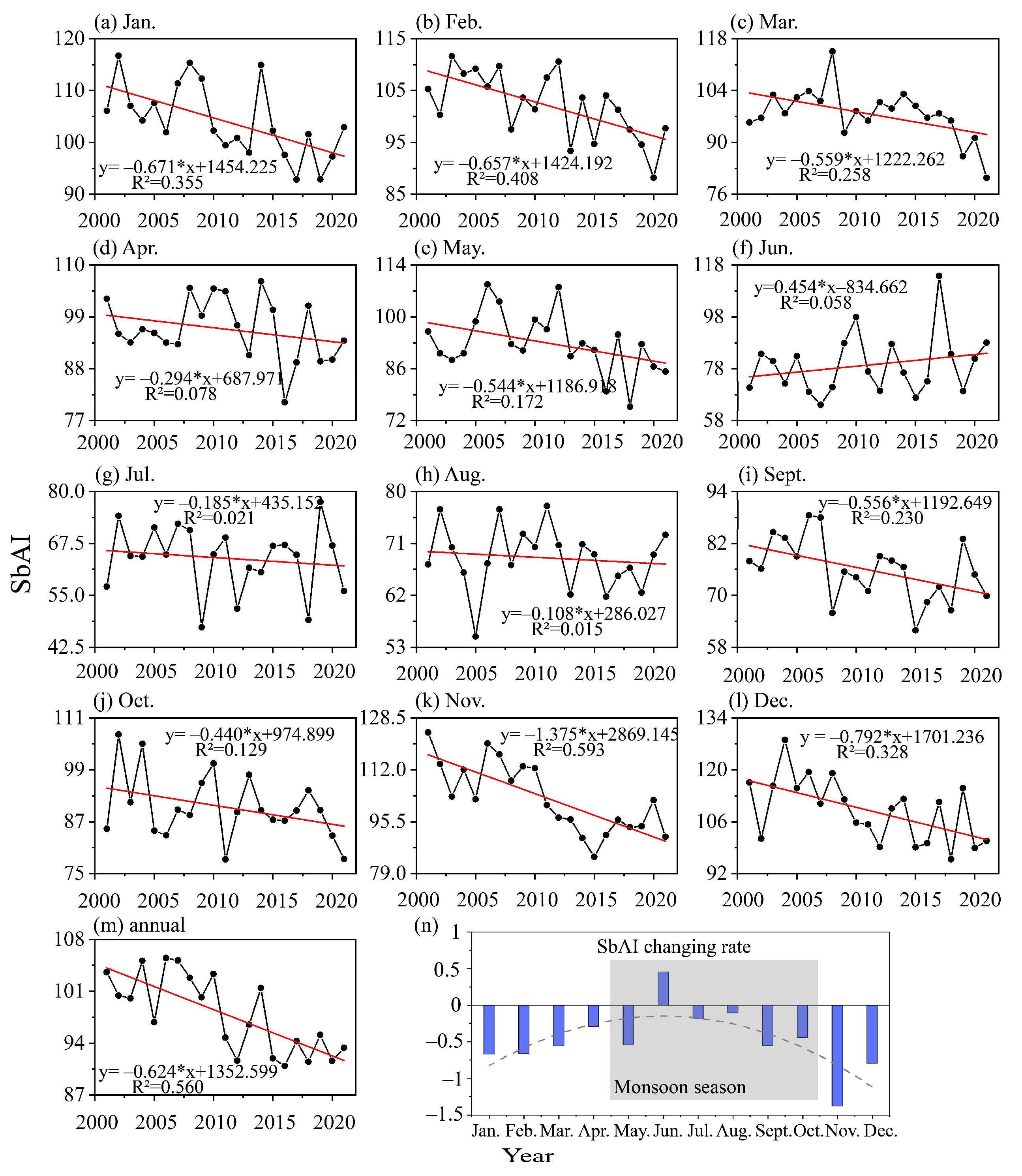


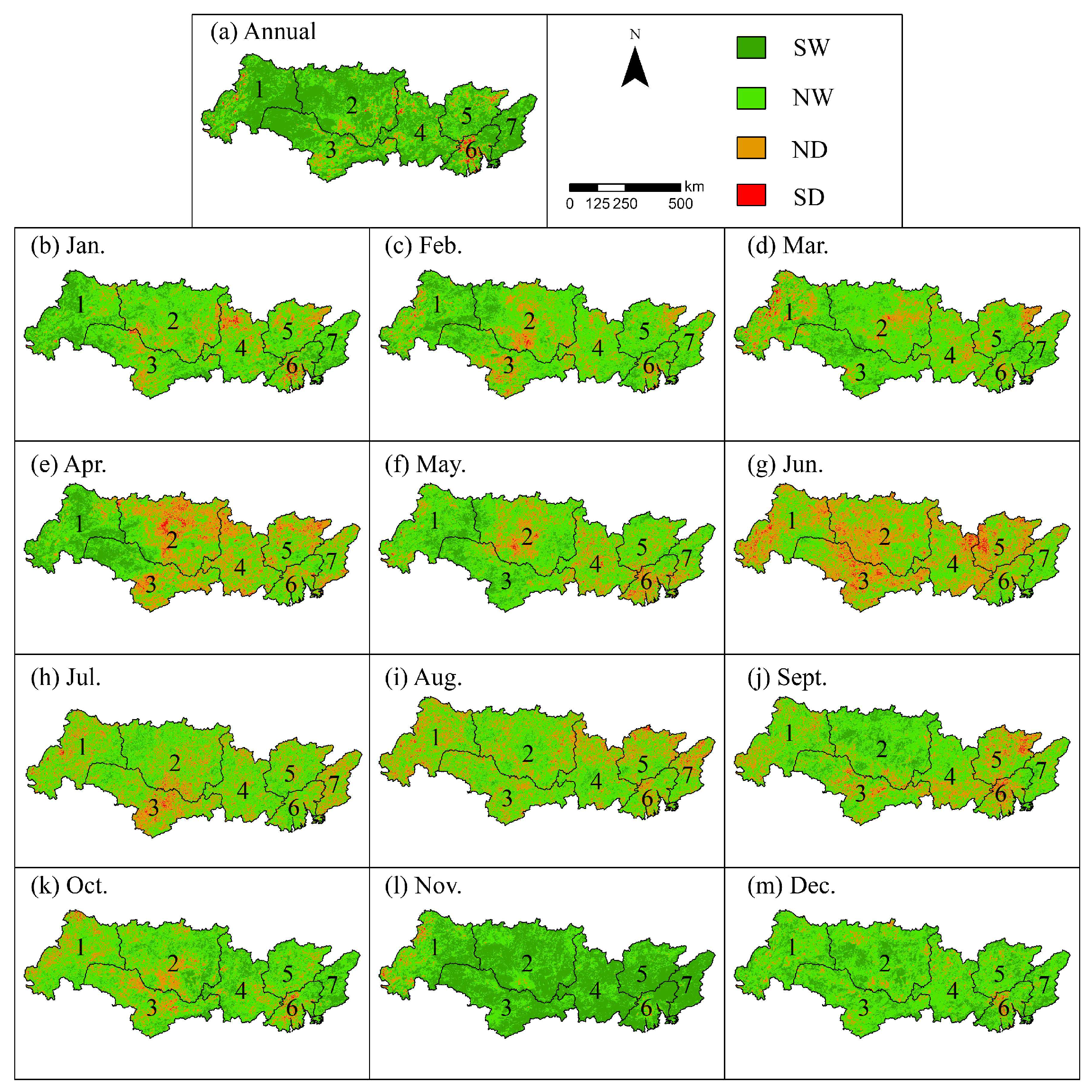


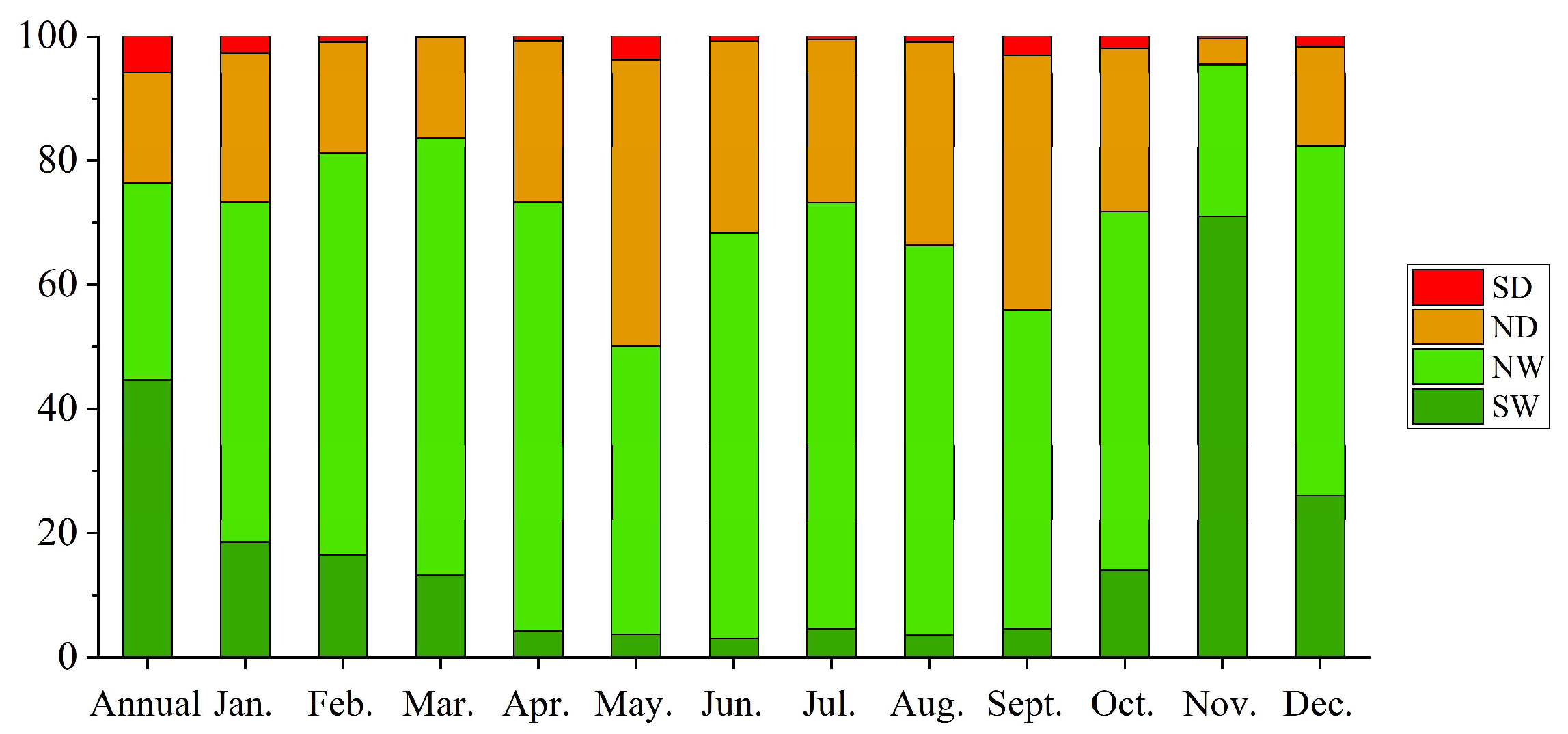


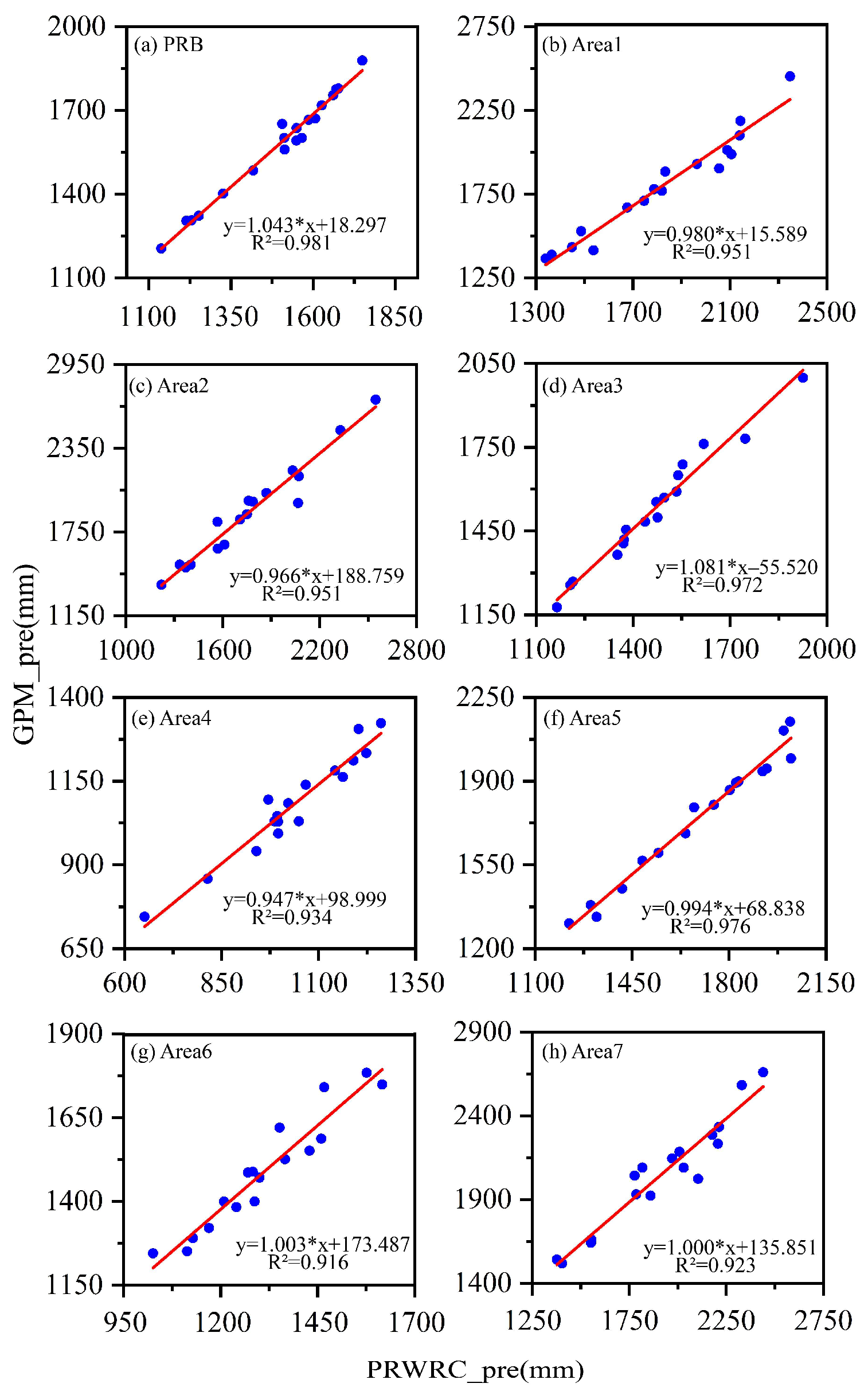
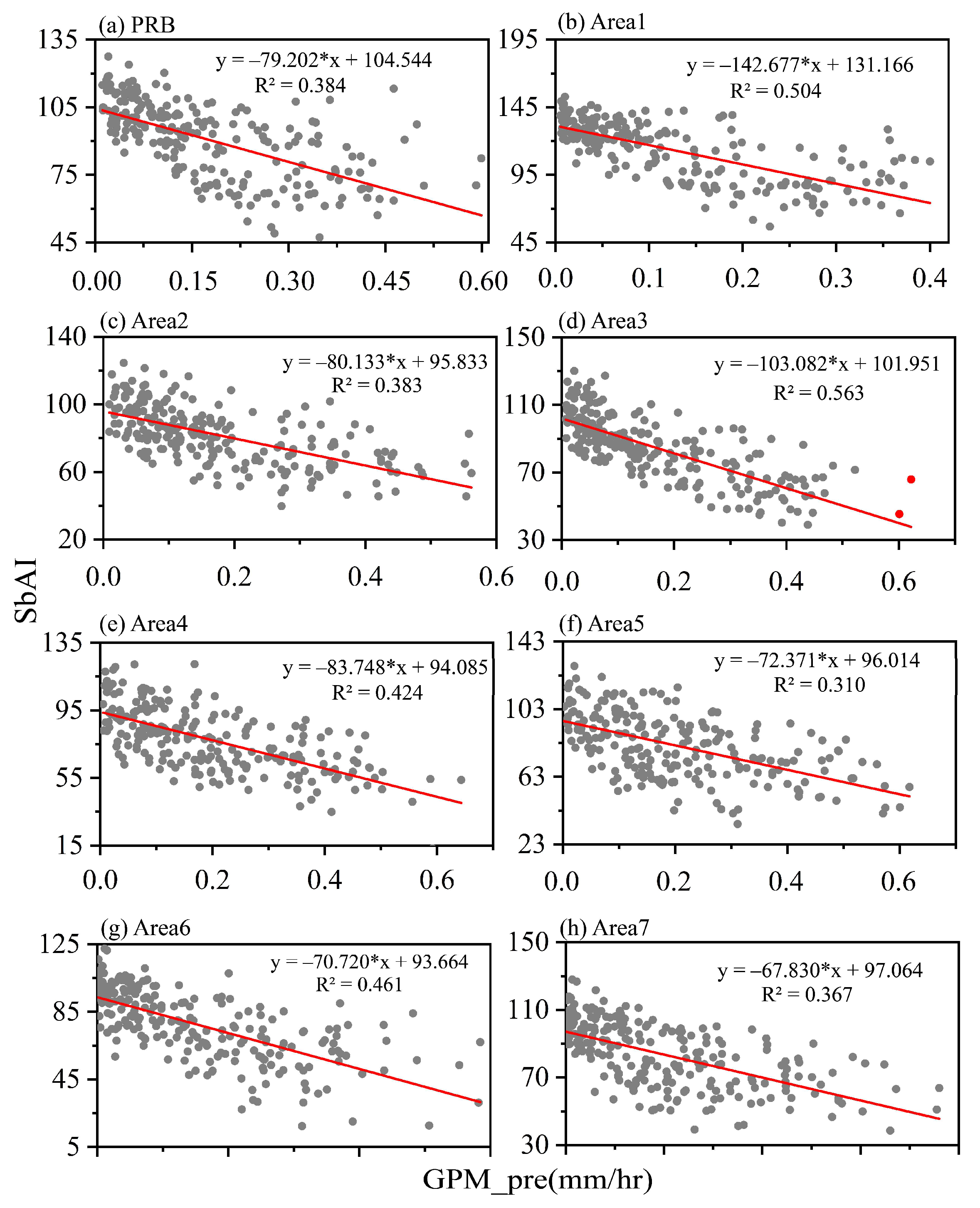
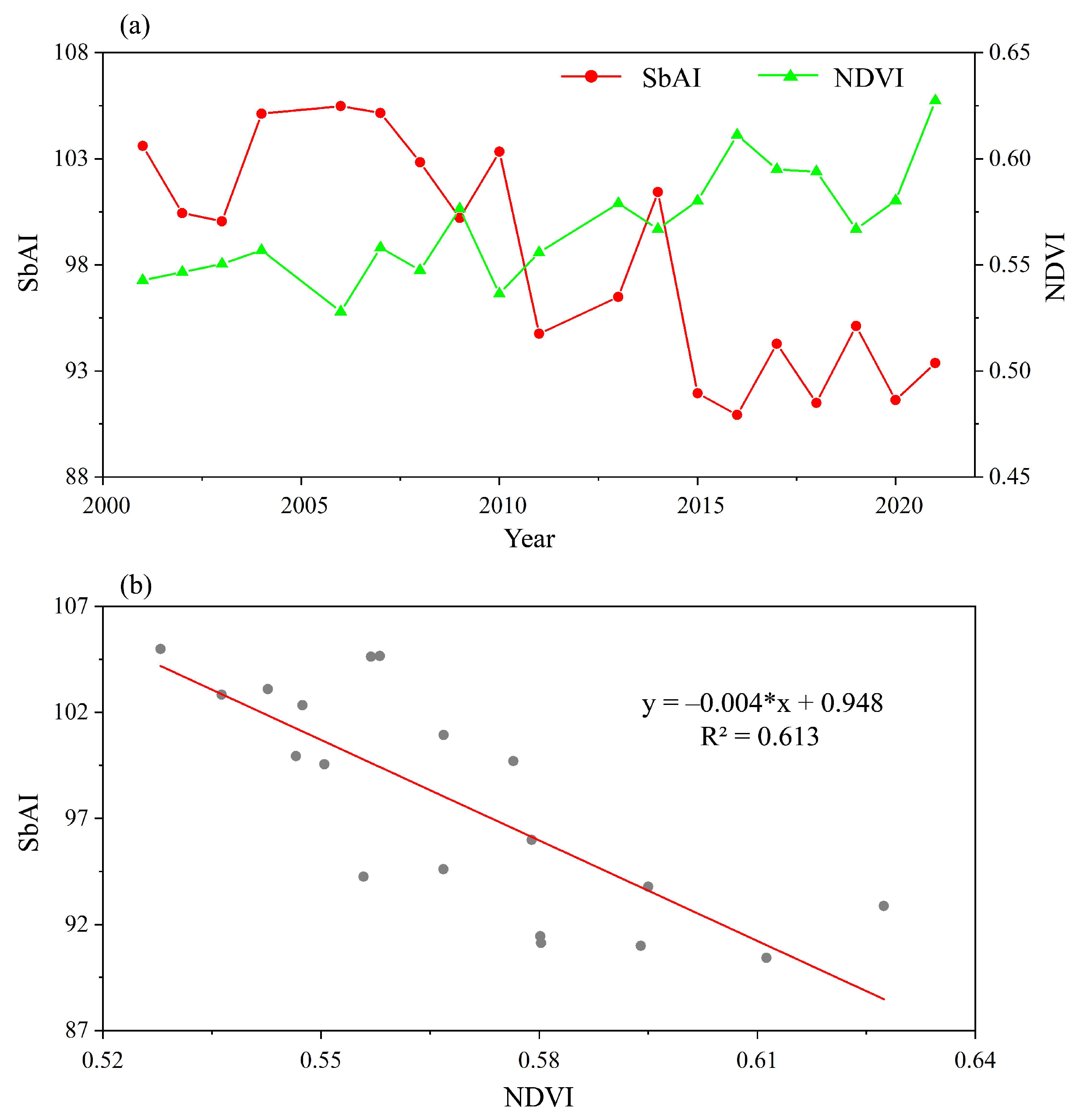
| PRB | Area 1 | Area 2 | Area 3 | Area 4 | Area 5 | Area 6 | Area 7 | |||||||||||||||||
|---|---|---|---|---|---|---|---|---|---|---|---|---|---|---|---|---|---|---|---|---|---|---|---|---|
| z | Slope | Year | z | Slope | Year | z | Slope | Year | z | Slope | Year | z | Slope | Year | z | Slope | Year | z | Slope | Year | z | Slope | Year | |
| Annual | −3.29 *** | −0.60 | 2005 | −3.35 *** | −0.80 | 2013 | −3.23 *** | −0.70 | 2010 | −2.75 *** | −0.65 | 2003 | −2.51 ** | −0.47 | 2010 | −2.45 ** | −0.42 | 2007 | −2.14 ** | −0.42 | 2010 | −3.47 *** | −0.76 | 2007 |
| January | −2.81 *** | −0.69 | 2010 | −2.45 ** | −0.94 | 2014 | −1.06 | −0.50 | 2014 | −1.24 | −0.59 | 2015 | −0.27 | −0.15 | 2014 | −0.09 | −0.04 | 2015 | −1.54 | −0.41 | 2009 | −1.66 ** | −0.82 | 2015 |
| February | −2.75 *** | −0.69 | 2017 | −2.26 *** | −0.72 | 2014 | −1.18 | −0.54 | 2008 | −1.54 | −0.37 | 2013 | −1.72 * | −0.67 | 2005 | −0.94 | −0.24 | 2013 | −2.02 ** | −0.79 | 2004 | −1.66 * | −0.58 | 2012 |
| March | −1.96 ** | −0.45 | 2008 | −1.12 | −0.42 | 2010 | −0.94 | −0.60 | 2008 | −2.26 ** | −1.17 | 2008 | −0.15 | −0.09 | 2006 | −0.39 | −0.30 | 2011 | −1.66 * | −0.67 | 2007 | −2.08 ** | −0.76 | 2005 |
| April | −1.06 | −0.30 | 2009 | −3.11 *** | −1.08 | 2013 | 0.00 | 0.00 | 2015 | −1.72 * | −0.49 | 2010 | 0.27 | 0.26 | 2006 | 0.63 | 0.26 | 2017 | −0.94 | −0.50 | 2008 | 0.33 | 0.12 | 2017 |
| May | −1.66 * | −0.51 | 2011 | −2.14 ** | −1.23 | 2012 | −1.60 | −0.78 | 2008 | −3.35 *** | −1.26 | 2012 | −0.88 | −0.46 | 2013 | −1.78 * | −1.04 | 2011 | −1.42 | −0.63 | 2013 | −2.14 ** | −0.97 | 2013 |
| June | 0.75 | 0.34 | 2008 | 0.69 | 0.17 | 2017 | 0.33 | 0.34 | 2012 | 0.09 | 0.10 | 2012 | 0.27 | 0.15 | 2009 | 0.82 | 0.65 | 2010 | −0.63 | −0.44 | 2006 | −0.39 | −0.22 | 2010 |
| July | −0.51 | −0.29 | 2008 | −1.12 | −0.45 | 2008 | −1.54 | −0.38 | 2011 | −0.45 | −0.21 | 2006 | −1.90 * | −0.76 | 2016 | −1.06 | −0.48 | 2008 | −1.36 | −0.94 | 2016 | −0.51 | −0.13 | 2008 |
| August | −0.57 | −0.11 | 2012 | −0.21 | −0.12 | 2018 | −0.45 | −0.14 | 2012 | −1.00 | −0.34 | 2012 | −0.33 | −0.09 | 2017 | 0.75 | 0.23 | 2005 | −1.00 | −0.43 | 2008 | 0.09 | 0.02 | 2019 |
| September | −2.08 ** | −0.57 | 2007 | −1.90 * | −0.74 | 2005 | −2.08 ** | −0.94 | 2007 | −1.00 | −0.38 | 2007 | −0.75 | −0.26 | 2007 | 0.33 | 0.07 | 2007 | −0.03 | −0.03 | 2007 | −1.66 * | −0.49 | 2006 |
| October | −1.30 | −0.34 | 2011 | −0.39 | −0.42 | 2006 | −0.94 | −0.35 | 2011 | 0.00 | −0.01 | 2005 | −2.02 ** | −0.66 | 2015 | −1.66 * | −0.57 | 2008 | −1.12 | −0.40 | 2018 | −2.26 ** | −0.88 | 2015 |
| November | −3.77 *** | −1.35 | 2011 | −2.81 *** | −0.87 | 2011 | −3.05 *** | −1.40 | 2010 | −2.87 *** | −1.47 | 2010 | −2.87 *** | −1.63 | 2010 | −3.17 *** | −1.48 | 2012 | −4.14 *** | −1.65 | 2008 | −4.14 *** | −1.72 | 2010 |
| December | −2.81 *** | −0.88 | 2011 | −2.51 ** | −0.69 | 2009 | −2.51 ** | −0.94 | 2009 | −1.90 * | −0.98 | 2014 | −1.78 * | −0.70 | 2014 | −2.26 ** | −0.73 | 2008 | −1.90 * | −0.54 | 2017 | −2.02 ** | −0.89 | 2014 |
| Start Year | Start Month | End Year | End Month | Duration | Severity | Intensity |
|---|---|---|---|---|---|---|
| 2001 | 1 | 2001 | 2 | 2 | 211.42 | 105.71 |
| 2001 | 11 | 2002 | 1 | 3 | 356.69 | 118.9 |
| 2002 | 10 | 2003 | 3 | 6 | 642.96 | 107.16 |
| 2003 | 11 | 2004 | 2 | 4 | 431.15 | 107.79 |
| 2004 | 10 | 2005 | 3 | 6 | 662.99 | 110.5 |
| 2005 | 11 | 2006 | 3 | 5 | 528.28 | 105.66 |
| 2006 | 11 | 2007 | 3 | 5 | 560.9 | 112.18 |
| 2007 | 11 | 2008 | 1 | 3 | 342.58 | 114.19 |
| 2008 | 3 | 2008 | 4 | 2 | 219.19 | 109.59 |
| 2008 | 11 | 2009 | 2 | 4 | 443.07 | 110.77 |
| 2009 | 11 | 2010 | 2 | 4 | 428.2 | 107.05 |
| 2010 | 11 | 2010 | 12 | 2 | 217.74 | 108.87 |
| 2011 | 11 | 2012 | 2 | 4 | 416.95 | 104.24 |
| 2013 | 12 | 2014 | 4 | 5 | 536.69 | 107.34 |
| 2014 | 12 | 2015 | 1 | 2 | 213.85 | 106.92 |
| 2017 | 12 | 2018 | 1 | 2 | 212.31 | 106.16 |
| Annual | January | February | March | April | May | June | July | August | September | October | November | December | ||
|---|---|---|---|---|---|---|---|---|---|---|---|---|---|---|
| Area 1 | mean | 124.30 | 130.21 | 131.59 | 127.53 | 130.67 | 128.19 | 99.13 | 81.33 | 84.11 | 92.87 | 105.62 | 122.58 | 128.33 |
| slope | −0.77 | −0.93 | −0.69 | −0.33 | −0.96 | −1.10 | 0.38 | −0.46 | −0.07 | −0.75 | −0.20 | −0.88 | −0.83 | |
| Area 6 | mean | 87.86 | 96.77 | 94.40 | 85.36 | 80.65 | 67.05 | 55.27 | 49.92 | 58.11 | 64.57 | 78.22 | 93.88 | 98.97 |
| slope | −0.40 | −0.51 | −0.79 | −0.77 | −0.43 | −0.75 | −0.02 | −0.69 | −0.44 | −0.14 | −0.45 | −1.56 | −0.60 |
Publisher’s Note: MDPI stays neutral with regard to jurisdictional claims in published maps and institutional affiliations. |
© 2022 by the authors. Licensee MDPI, Basel, Switzerland. This article is an open access article distributed under the terms and conditions of the Creative Commons Attribution (CC BY) license (https://creativecommons.org/licenses/by/4.0/).
Share and Cite
Niu, K.; Qiu, J.; Cai, S.; Zhang, W.; Mu, X.; Park, E.; Yang, X. Use of a MODIS Satellite-Based Aridity Index to Monitor Drought Conditions in the Pearl River Basin from 2001 to 2021. ISPRS Int. J. Geo-Inf. 2022, 11, 541. https://doi.org/10.3390/ijgi11110541
Niu K, Qiu J, Cai S, Zhang W, Mu X, Park E, Yang X. Use of a MODIS Satellite-Based Aridity Index to Monitor Drought Conditions in the Pearl River Basin from 2001 to 2021. ISPRS International Journal of Geo-Information. 2022; 11(11):541. https://doi.org/10.3390/ijgi11110541
Chicago/Turabian StyleNiu, Kunlong, Junliang Qiu, Shirong Cai, Wenxin Zhang, Xiaolin Mu, Edward Park, and Xiankun Yang. 2022. "Use of a MODIS Satellite-Based Aridity Index to Monitor Drought Conditions in the Pearl River Basin from 2001 to 2021" ISPRS International Journal of Geo-Information 11, no. 11: 541. https://doi.org/10.3390/ijgi11110541
APA StyleNiu, K., Qiu, J., Cai, S., Zhang, W., Mu, X., Park, E., & Yang, X. (2022). Use of a MODIS Satellite-Based Aridity Index to Monitor Drought Conditions in the Pearl River Basin from 2001 to 2021. ISPRS International Journal of Geo-Information, 11(11), 541. https://doi.org/10.3390/ijgi11110541









